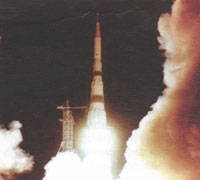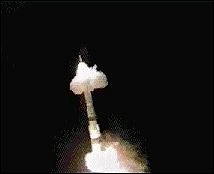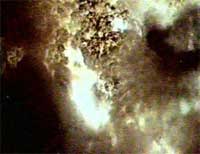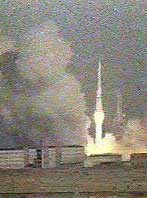Soviet Moon Race
Launches
By the end of summer in 1968 sixteen N1 flight vehicles, and two N1 mock-ups were being built to support the Soviet manned lunar effort. However manufacturing problems with the rockets massive fuel tanks postponed the first planned launch until early 1969.
The four launches that occurred between 1969 to 1972 had the flight serial numbers of 3L, 5L, 6L and 7L.
 N1-3L N1-3L
On February 21, 1969 , N1 serial number 3L rose into the sky, thundering over the roofs of the assembly worker's apartments as they cheered it on. But trouble was afoot. Small metallic particles lodged in the gas generator turbine of engine 2. This resulted in a rising high frequency oscillation, eventually causing some engine components to fatigue and tear off their mounts. A forced leak of propellants followed, setting in motion a fire in the tail compartment. The KORD's BKS engine monitoring system detected the fire, but then gave an incorrect signal shutting down all engines at 68.7 seconds into the flight. The vehicle was destroyed by range safety 1.3 seconds later. The SAS escape tower worked as designed and the 7K-L1S capsule was recovered. The main body of the rocket impacted 45 km downrange from the launch pad.
 N1-5L N1-5L
The second launch attempt occurred with vehicle 5L on July 3 1969 , just two weeks before the Apollo 11 first moon landing mission. It was a catastrophe. 5L already began to fail at 0.25 second after lift-off when the oxidizer pump of engine number 8 ingested a slag fragment and exploded. A fire ensued as the vehicle climbed past the top of the tower. The KORD reacted and engines were shut down in pairs until the acceleration dropped below 1 G; then the vehicle began to fall back to the pad at a 45 degree angle. The escape tower fired at the top of the brief trajectory, taking the L1S descent module away from the pad. Upon impact of the base of the N1 with the pad, the vehicle exploded with the force of a small nuclear bomb, destroying launch complex 110R. US weather and meteorological satellites revealed the disaster to the US intelligence agencies, and word soon spread through the government.
 N1-6L N1-6L
A substantially improved N1 with the serial number 6L was launched on 26 June 1971 . After liftoff and ascent, an axial rotation was introduced by gas dynamics interactions of the thirty engines with the air slipstream. The launch vehicle developed a roll beyond the capability of the control system to compensate. and began to break up as it went through Max Q. Control was lost at 50.2 seconds into the flight and it was destroyed by range safety a second later. The engines functioned well and did not shut down up to the point of vehicle destruction. No functional payload was carried.
 N1-7L N1-7L
The last flight of an N1 occurred on 23 November 1972 with a flight designation of N-1 7L. This article incorporated significant changes to the previous model, including roll control 'steering' engines to prevent the loss of control that destroyed 6L. The rocket ascended into the sky, and the engines ran 106.93 seconds, only seven seconds before completion of first stage burnout. Programmed shutdown of some engines to prevent overstressing of the structure led to propellant line hammering, rupture of propellant lines, and an explosion of engine number 4. The vehicle was destroyed by range safety.
This failure reinforced that the moon race was lost and the total program was cancelled in 1974.
|















